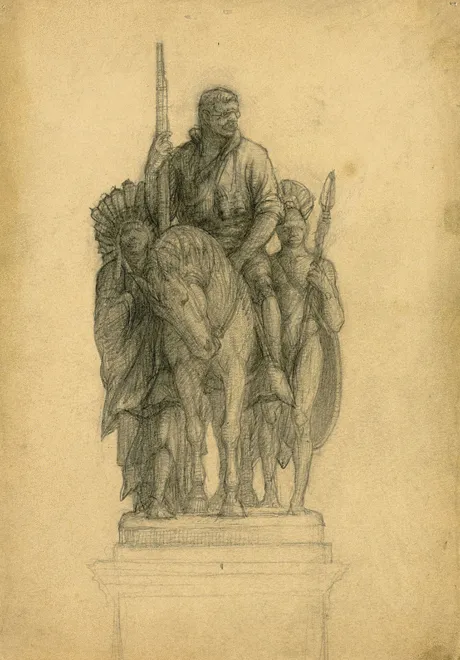Controversial Teddy Roosevelt Statue Will Be Moved From NYC to North Dakota
The equestrian monument will leave the steps of the American Museum of Natural History, finding a new home at the Theodore Roosevelt Presidential Library
:focal(1472x654:1473x655)/https://tf-cmsv2-smithsonianmag-media.s3.amazonaws.com/filer_public/12/66/1266bed6-5594-4426-b0c7-c7c26ffd6f7f/gettyimages-1221923476.jpg)
An infamous statue of President Theodore Roosevelt riding a horse as an African American man and a Native American man walk behind him has found a new home in North Dakota.
Currently installed at the entrance of the American Museum of Natural History (AMNH) in New York City, the sculpture will eventually go on view at the new Theodore Roosevelt Presidential Library in Medora. As Patrick Springer reports for Twin Cities, the library is scheduled to open in 2026 near Roosevelt’s onetime cattle ranch in the Little Missouri Badlands. The library’s foundation and the City of New York reached a long-term loan agreement allowing the statue to move to its new location.
NYC officials first announced plans for the statue’s removal last summer, in the wake of antiracism protests following the police killing of George Floyd, reported Robin Pogrebin for the New York Times in June 2020.
“We are grateful to the Theodore Roosevelt Presidential Library for proposing a fitting new home for the Equestrian Statue,” says Vicki Been, New York City deputy mayor for housing and economic development, in a statement. “This long-term loan [will] allow an important part of the city’s art collection to be appropriately contextualized, and we look forward to continuing to work with the library on next steps.”

The library’s board says in the statement that it “believes the Equestrian Statue is problematic in its composition,” adding that its current location outside of the museum does not provide appropriate context. Under the new agreement, the library will store the statue while determining how to present it to the public. It plans to establish an advisory council with representatives of Indigenous and Black communities, historians, scholars, and artists guiding the process.
In the statement, Theodore Roosevelt V, the president’s great-great-grandson and a trustee of the museum, describes the statue as “problematic in its hierarchical depiction of its subjects.”
He adds, “[It] should be removed from New York State’s official memorial to Theodore Roosevelt. Rather than burying a troubling work of art, we ought to learn from it. It is fitting that the statue is being relocated to a place where its composition can be recontextualized to facilitate difficult, complex and inclusive discussions.”
The statue has stood at AMNH’s entrance, on land owned by New York City, since 1940, reports Wallace Ludel for the Art Newspaper. The original intent behind the statue’s design, which was overseen by a commission created by the New York State Legislature, was to “express Roosevelt’s life as a nature lover, naturalist, explorer and author of works of natural history,” as the memorial’s Board of Trustees said at the time. Per AMNH, James Earle Fraser, who sculpted the monument, stated that the “guides” at Roosevelt’s side symbolized “the continents of Africa and America, and if you choose may stand for Roosevelt’s friendliness to all races.”
/https://tf-cmsv2-smithsonianmag-media.s3.amazonaws.com/filer_public/62/bc/62bc7079-ba55-4736-ba66-81062b9433e1/wooden-mockup-roosevelt-statue-1129-1400_full_610.jpg)
Critics of the statue have emphasized not only the deferential position of the two other figures but also Roosevelt’s racist beliefs and actions. The president’s well-known efforts to create the national park system involved the evacuation of Native Americans from their land. He supported the expansion of United States imperial power during the 1898 Spanish-American War and the war with supporters of independence for the Philippines that followed. He was also a proponent of some elements of eugenics.
“[H]e was certainly the kind of progressive politician of the early 20th century who started moving the United States forward on environmental and other issues,” Cornell historian David Silbey told NBC News last year. “But he was also [a] racist who viewed other peoples around the world as distinctly inferior to Americans.”
New York City Mayor Bill de Blasio announced that the city would remove the statue last June, after the museum requested that it do so. A year later, the New York City Public Design Commission unanimously voted in favor of the removal.
The process of moving the statue is set to begin this fall and will take several months, says AMNH president Ellen V. Futter in the statement.
/https://tf-cmsv2-smithsonianmag-media.s3.amazonaws.com/accounts/headshot/Livia_lg_thumbnail.png)
/https://tf-cmsv2-smithsonianmag-media.s3.amazonaws.com/accounts/headshot/Livia_lg_thumbnail.png)